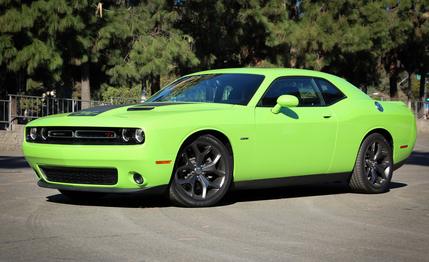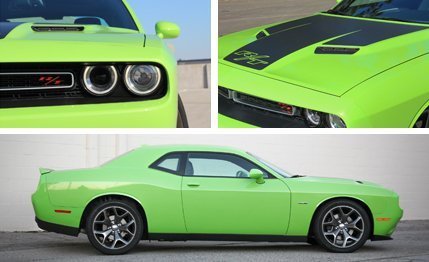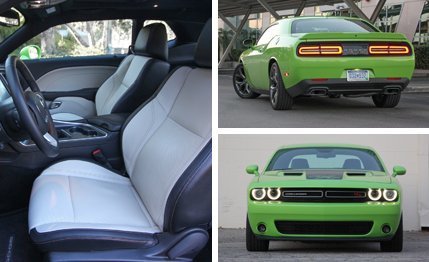 Instrumented Test
Instrumented Test
A lot has changed since 2008, but the Dodge Challenger R/T hasn’t. When Dodge rolled out the retro-styled beast to battle the Ford Mustang—the Chevy Camaro was still on hiatus—we actually found the 376-hp 5.7-liter Hemi-powered R/T model (introduced for 2009) preferable to the slightly quicker, 425-hp 6.1-liter SRT8. But in the years since, the larger Hemi has grown to 6.4 liters and now churns out a tire-melting 485 horsepower. The model with that engine was eventually renamed SRT 392, and its spot at the top of the pecking order was usurped by not one but two new members of the Challenger family that Dodge added for 2015: the 6.4-liter R/T Scat Pack and, of course, the 707-hp Hellcat. Those moves render the 5.7-liter R/T the fourth-quickest Challenger model. Yep, it’s a brave, burlier new world.
The fact remains, however, that the 5.7-liter R/T wasn’t slow when we tested a 2009 R/T manual back in 2008, and it’s not slow now: the 4100-pound five-seater can hit 60 mph in 5.1 seconds, exactly the same as before, and punches the quarter-mile clock in 13.7 seconds at a speed of 103 mph, 0.1-second and 3-mph slower than the 2009 model. Yet it feels comparatively lazy driven back-to-back with the Scat Pack we tested at the same time, as that model hits 60 in 4.2 seconds and runs the quarter in 12.6 at 114 mph. The Tremec TR-6060 six-speed is quite nice, at least, with clearly defined gates, a communicative clutch, and just enough heft to match the car’s aggressive personality. We only wish Dodge would do away with the first-to-fourth skip-shift action at partial throttle, an annoying fuel-saving device.

The R/T holds on in corners, but it’s hardly glued to the asphalt. Despite riding on the optional Super Track Pak suspension, which lowers the car by half an inch and wraps the 20-inch wheels with 245/45 Y-rated Goodyear Eagle F1 Supercar tires, our test car pulled 0.89 g on the skidpad while exhibiting moderate understeer. That said, with 410 lb-ft of torque available at 4300 rpm, the R/T’s rear end has a real penchant for scooting around with a goose of the throttle—classic muscle-car stuff that is quite entertaining if you know what you’re doing. And as with other Challengers with the Super Track Pak, the performance steering is sharp and communicative. Meanwhile, braking from 70 mph has improved by six feet over the 2009 model, to a fade-free 167 feet. Still, that’s a Mini Cooper longer than the Scat Pack, as its four-piston Brembo clampers facilitate rock-star 154-foot stops.
For a car whose exterior design hasn’t changed much since 2008—’71-look grille innards and split LED taillamps are the major differences for 2015—the Challenger looks remarkably fresh, and our tester’s Sublime green paint and dark 20-inch wheels made this car as fun to look at as any Challenger we’ve tested previously.
While little has changed on the outside or under the hood, the cabin has been drastically updated. Back in 2008, we accepted the Challenger’s cheap interior because, well, it was wrapped in a Challenger. Now, no apologies must be made. The new interior has a more retro flavor, thanks to a dashboard inspired by the ’71 Challenger, but the latest Uconnect infotainment also means it’s much more modern, especially with the Challenger’s Performance Pages app, which can monitor and upload to the web performance and handling stats (it’s included with the Super Track Pak). The cabin is also quite accommodating—the car is basically a shortened Charger sedan, after all—with comfortable front seats and a wide, three-butt rear bench, making it the most usable five-seat two-door coupe available in the U.S.

So the R/T looks, goes, and stops much as it has all along, and it delivers an entertaining driving experience. But at the end of the test, we were far less enthusiastic about this model than we were back in 2008. Lighter, nimbler cars like the 2015 Mustang and the Chevy Camaro SS make the heavy Challenger R/T feel like a lumbering beast, and no matter how quick or sweet-sounding it may be, there’s something de-spiriting about its status as fourth out of five in the Challenger pecking order. At least the car’s base price has climbed by less than $1000 in the last six years, from $31,540 to $32,490.
In any case, when time comes to replace the Challenger sometime in 2018, Dodge will find itself at a crossroads, facing the decision of whether to chase the Camaro SS and the Mustang GT with a lighter, sportier entry or to double-down on the Challenger’s cruiser-car proclivities and chase buyers that Ford and Chevy will have abandoned. In the meantime, this tail-happy heavyweight probably won’t change much.